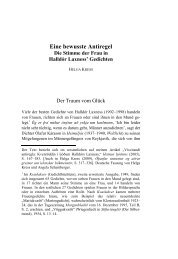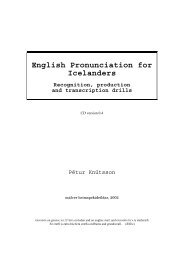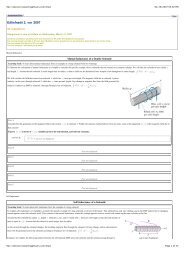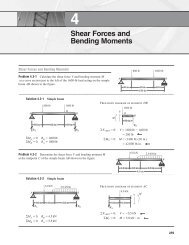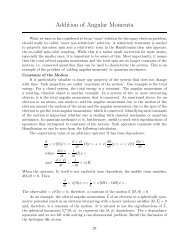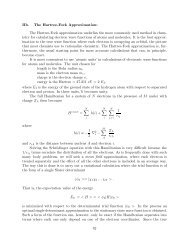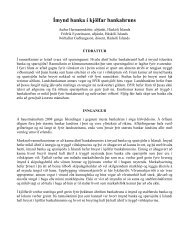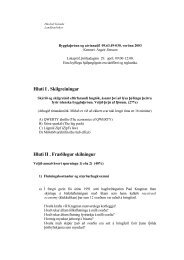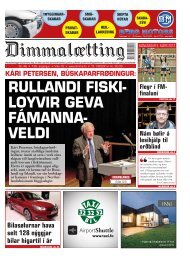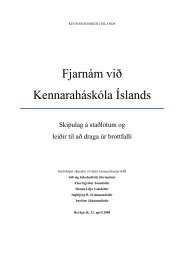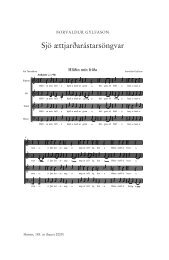Predicting the level of banks´ customer trust and forgiveness ...
Predicting the level of banks´ customer trust and forgiveness ...
Predicting the level of banks´ customer trust and forgiveness ...
Create successful ePaper yourself
Turn your PDF publications into a flip-book with our unique Google optimized e-Paper software.
The European Institute <strong>of</strong> Retailing <strong>and</strong> Services Studies<br />
Recent Advances in Retailing <strong>and</strong> Consumer Service Science<br />
Philadelphia, USA<br />
July 7-10, 2013<br />
<strong>Predicting</strong> <strong>the</strong> <strong>level</strong> <strong>of</strong> <strong>banks´</strong> <strong>customer</strong> <strong>trust</strong> <strong>and</strong><br />
<strong>forgiveness</strong> following a banking crisis: The case <strong>of</strong><br />
Icel<strong>and</strong><br />
Authors:<br />
Fridrik Eysteinsson, University <strong>of</strong> Icel<strong>and</strong> (fridrike@hi.is)<br />
School <strong>of</strong> Business, Gimli v/Saemundargata, 101 Reykjavik, Icel<strong>and</strong><br />
Thorhallur Gudlaugsson, University <strong>of</strong> Icel<strong>and</strong> (th@hi.is)<br />
School <strong>of</strong> Business, Gimli v/Saemundargata, 101 Reykjavik, Icel<strong>and</strong>
ABSTRACT<br />
In October 2008 Icel<strong>and</strong> experienced <strong>the</strong> deepest <strong>and</strong> most rapid financial crisis recorded in<br />
peacetime history. In a matter <strong>of</strong> days three <strong>of</strong> <strong>the</strong> country´s biggest retail banks, representing<br />
about 85% <strong>of</strong> total banking assets, collapsed along with <strong>the</strong> biggest savings <strong>and</strong> loans <strong>and</strong><br />
passed into government h<strong>and</strong>s. Customer <strong>trust</strong> towards <strong>the</strong> banks was lost.<br />
Business organizations <strong>and</strong> consumers were hard hit. Many <strong>customer</strong>s <strong>of</strong> <strong>the</strong> Icel<strong>and</strong>ic<br />
banks suffered additional harm because <strong>the</strong>y lost part <strong>of</strong> <strong>the</strong> money <strong>the</strong>y had invested in <strong>the</strong><br />
<strong>banks´</strong> money market funds, had taken out loans in foreign currencies which increased<br />
dramatically as a result <strong>of</strong> <strong>the</strong> fall <strong>of</strong> <strong>the</strong> value <strong>of</strong> <strong>the</strong> Icel<strong>and</strong>ic krona <strong>and</strong> lastly <strong>the</strong>y lost <strong>the</strong><br />
lion´s share <strong>of</strong> <strong>the</strong>ir investment in <strong>the</strong> <strong>banks´</strong> shares. The Icel<strong>and</strong>ic banks seem to have had a<br />
hard time earning <strong>customer</strong> <strong>forgiveness</strong> for <strong>the</strong> direct <strong>and</strong> indirect harm <strong>the</strong>y suffered as a<br />
consequence <strong>of</strong> <strong>the</strong>ir collapse.<br />
But how can banks repair <strong>customer</strong> <strong>trust</strong> <strong>and</strong> elicit <strong>the</strong>ir <strong>forgiveness</strong>? Xie <strong>and</strong> Peng put<br />
forth a model that has eight dimensions. Three kinds <strong>of</strong> repair efforts (affective, functional<br />
<strong>and</strong> informational) are posited to have an effect on three <strong>trust</strong>worthiness dimensions<br />
(integrity, competence <strong>and</strong> benevolence). The <strong>trust</strong>worthiness dimensions are <strong>the</strong>n posited to<br />
have an effect on <strong>forgiveness</strong> <strong>and</strong> <strong>trust</strong>. Finally, <strong>forgiveness</strong> is posited to have an effect on<br />
<strong>trust</strong>.<br />
To <strong>the</strong> best <strong>of</strong> <strong>the</strong> authors´ knowledge no papers investigating which dimensions <strong>of</strong> Xie<br />
<strong>and</strong> Peng´s (2009) model predict <strong>the</strong> <strong>level</strong> <strong>of</strong> <strong>customer</strong> <strong>trust</strong> <strong>and</strong> <strong>forgiveness</strong> have been<br />
published in scholarly journals let alone following a banking crisis. The authors´ research<br />
<strong>the</strong>refore aims to answer <strong>the</strong> four research questions:<br />
1. Which dimensions in Xie <strong>and</strong> Peng´s (2009) model predict <strong>the</strong> <strong>level</strong> <strong>of</strong> <strong>banks´</strong><br />
<strong>customer</strong> <strong>trust</strong> following a banking crisis?<br />
2. Which dimensions in Xie <strong>and</strong> Peng´s (2009) model are <strong>the</strong> most important in<br />
predicting <strong>the</strong> <strong>level</strong> <strong>of</strong> <strong>banks´</strong> <strong>customer</strong> <strong>trust</strong> following a banking crisis?<br />
3. Which dimensions in Xie <strong>and</strong> Peng´s (2009) model predict <strong>the</strong> <strong>level</strong> <strong>of</strong> <strong>banks´</strong><br />
<strong>customer</strong> <strong>forgiveness</strong> following a banking crisis?<br />
4. Which dimensions in Xie <strong>and</strong> Peng´s (2009) model are <strong>the</strong> most important in<br />
predicting <strong>the</strong> <strong>level</strong> <strong>of</strong> bank´s <strong>customer</strong> <strong>forgiveness</strong> following a banking crisis?<br />
1
INTRODUCTION<br />
Icel<strong>and</strong> is an isolated isl<strong>and</strong> located in <strong>the</strong> North Atlantic Ocean with a population <strong>of</strong> about<br />
320.000. Throughout <strong>the</strong> 19 th <strong>and</strong> <strong>the</strong> first decades <strong>of</strong> <strong>the</strong> 20 th century, Icel<strong>and</strong> was one <strong>of</strong> <strong>the</strong><br />
poorest countries in Europe but at <strong>the</strong> turn <strong>of</strong> <strong>the</strong> last century it was one <strong>of</strong> <strong>the</strong> most<br />
prosperous countries in <strong>the</strong> world. In 1995 its banking sectors´ <strong>level</strong> <strong>of</strong> foreign debt was 6%<br />
<strong>of</strong> GDP. In 2004 that <strong>level</strong> was 138% <strong>and</strong> had grown to about ten times GDP by <strong>the</strong> end <strong>of</strong><br />
2007.<br />
In October 2008 following serious liquidity problems, three <strong>of</strong> <strong>the</strong> biggest Icel<strong>and</strong>ic<br />
banks, representing about 85% <strong>of</strong> total banking assets, collapsed along with <strong>the</strong> biggest<br />
savings <strong>and</strong> loans. The banks had become too big for <strong>the</strong> Central Bank (or <strong>the</strong> government for<br />
that matter) to rescue. As a consequence Icel<strong>and</strong> experienced <strong>the</strong> deepest <strong>and</strong> most rapid<br />
financial crisis in peacetime history. Customer <strong>trust</strong> towards <strong>the</strong> Icel<strong>and</strong>ic banks went down<br />
considerably (Eysteinsson <strong>and</strong> Gudlaugsson, 2011; Friðrik Eysteinsson <strong>and</strong> Þórhallur<br />
Guðlaugsson, 2011; Gudlaugsson <strong>and</strong> Eysteinsson, 2010, 2012a, 2012b; Þórhallur<br />
Guðlaugsson <strong>and</strong> Friðrik Eysteinsson, 2010).<br />
After <strong>the</strong> crisis <strong>the</strong> price <strong>of</strong> real estate went down <strong>and</strong> <strong>the</strong> bottom fell out <strong>of</strong> <strong>the</strong><br />
Icel<strong>and</strong>ic stock market. The value <strong>of</strong> <strong>the</strong> Icel<strong>and</strong>ic krona fell dramatically. Public <strong>and</strong> private<br />
debt went up because <strong>of</strong> indexation <strong>and</strong> disposable income <strong>and</strong> purchasing power decreased.<br />
Business organizations <strong>and</strong> consumers were hard hit. Many <strong>customer</strong>s <strong>of</strong> <strong>the</strong> Icel<strong>and</strong>ic banks<br />
suffered additional harm because <strong>the</strong>y lost part <strong>of</strong> <strong>the</strong> money <strong>the</strong>y had invested in <strong>the</strong> <strong>banks´</strong><br />
money market funds, had taken out loans in foreign currencies which increased dramatically<br />
as a result <strong>of</strong> <strong>the</strong> fall <strong>of</strong> <strong>the</strong> value <strong>of</strong> <strong>the</strong> Icel<strong>and</strong>ic krona <strong>and</strong> lastly <strong>the</strong>y lost <strong>the</strong> lion´s share <strong>of</strong><br />
<strong>the</strong>ir investments in <strong>the</strong> <strong>banks´</strong> shares. The Icel<strong>and</strong>ic banks seem to have had a hard time<br />
earning <strong>customer</strong> <strong>forgiveness</strong> for <strong>the</strong> direct <strong>and</strong> indirect harm <strong>the</strong>y suffered as a consequence<br />
<strong>of</strong> <strong>the</strong>ir collapse (Brynjar Smári Rúnarsson <strong>and</strong> Friðrik Eysteinsson, 2011).<br />
The paper is split into four sections. The first section deals with <strong>the</strong> state <strong>of</strong> knowledge.<br />
The second one details <strong>the</strong> methodology. The third presents <strong>the</strong> findings <strong>and</strong> finally <strong>the</strong><br />
implications are discussed in <strong>the</strong> discussion section.<br />
1 THEORETICAL BACKGROUND<br />
Moorman, Zaltman <strong>and</strong> Desp<strong>and</strong>e (1992, page 315) define <strong>trust</strong> as “a willingness to rely on<br />
an exchange partner in whom one has confidence”. Sirdeshmukh, Singh <strong>and</strong> Sabol (1992,<br />
2
page 17) define it as “<strong>the</strong> expectations held by <strong>the</strong> consumer that <strong>the</strong> service provider is<br />
dependable <strong>and</strong> can be relied on to deliver on its promise”. Trust applies to both individuals<br />
<strong>and</strong> business organizations (Jones, Wilkens, Morris <strong>and</strong> Masera, 2000). A lack <strong>of</strong> <strong>trust</strong> can<br />
lead to a competitive disadvantage (Barney <strong>and</strong> Hansen, 1994).<br />
Researchers have defined <strong>forgiveness</strong> in a variety <strong>of</strong> ways, so <strong>the</strong>re is no consensus on<br />
its definition (Finkel, Rusbult, Kumashiro <strong>and</strong> Hannon, 2002). In this paper <strong>the</strong> authors adopt<br />
Xie <strong>and</strong> Peng´s (2009, page 578) definition <strong>and</strong> define <strong>customer</strong> <strong>forgiveness</strong> as “<strong>customer</strong>´s<br />
willingness to give up retaliation, alienation, <strong>and</strong> o<strong>the</strong>r destructive behaviors, <strong>and</strong> to respond<br />
in constructive ways after an organizational violation <strong>of</strong> <strong>trust</strong> <strong>and</strong> <strong>the</strong> related recovery<br />
efforts.” According to Tsarenko <strong>and</strong> Gabbot (2006) <strong>forgiveness</strong> has <strong>the</strong> potential to accelerate<br />
<strong>the</strong> restoration <strong>of</strong> a strained relationship between a service provider <strong>and</strong> <strong>customer</strong>. Chung <strong>and</strong><br />
Beverl<strong>and</strong> (2006) maintain that <strong>forgiveness</strong> may not only restore a relationship to its original<br />
state but also enhance its quality. Little is known, however, about <strong>customer</strong> <strong>forgiveness</strong><br />
(Zourrig, Chebat <strong>and</strong> T<strong>of</strong>foli, 2009).<br />
Xie <strong>and</strong> Peng (2009) conducted a scenario-based experiment which revolved around<br />
how to regain <strong>customer</strong> <strong>trust</strong> <strong>and</strong> elicit <strong>the</strong>ir <strong>forgiveness</strong>. They put forth a model that has<br />
eight dimensions. Three kinds <strong>of</strong> repair efforts (affective, functional <strong>and</strong> informational) are<br />
posited to have an effect on three <strong>trust</strong>worthiness dimensions (integrity, competence <strong>and</strong><br />
benevolence). The <strong>trust</strong>worthiness dimensions are <strong>the</strong>n posited to have an effect on<br />
<strong>forgiveness</strong> <strong>and</strong> <strong>trust</strong>. Finally, <strong>forgiveness</strong> is posited to have an effect on <strong>trust</strong>. Their research<br />
confirmed, among o<strong>the</strong>r things, that affective, functional <strong>and</strong> informational repair efforts all<br />
had an effect on <strong>trust</strong>worthiness <strong>and</strong> that all <strong>the</strong> <strong>trust</strong>worthiness dimensions had a positive<br />
effect on <strong>customer</strong> <strong>forgiveness</strong> <strong>and</strong> <strong>trust</strong>. Finally, <strong>the</strong>re was a positive relationship between<br />
<strong>forgiveness</strong> <strong>and</strong> <strong>trust</strong>.<br />
Brynjar Smári Rúnarsson <strong>and</strong> Friðrik Eysteinsson (2011) did a study among <strong>the</strong><br />
<strong>customer</strong>s <strong>of</strong> <strong>the</strong> Icel<strong>and</strong>ic banks following <strong>the</strong> banking crisis. Their conclusion was that <strong>the</strong>re<br />
was a positive relationship between <strong>the</strong> repair efforts <strong>and</strong> <strong>the</strong> perceived <strong>trust</strong>worthiness<br />
dimensions <strong>and</strong> <strong>the</strong> perceived <strong>trust</strong>worthiness dimensions <strong>and</strong> both <strong>forgiveness</strong> <strong>and</strong> <strong>trust</strong>.<br />
Finally, <strong>the</strong>re was a positive relationship between <strong>forgiveness</strong> <strong>and</strong> <strong>trust</strong>.<br />
To <strong>the</strong> best <strong>of</strong> <strong>the</strong> authors´ knowledge no papers investigating <strong>the</strong> dimensions in Xie<br />
<strong>and</strong> Peng´s (2009) model that predict <strong>the</strong> <strong>level</strong> <strong>of</strong> <strong>customer</strong> <strong>trust</strong> <strong>and</strong> <strong>forgiveness</strong> have been<br />
published in scholarly journals let alone following a banking crisis. The authors´ research<br />
<strong>the</strong>refore aims to answer <strong>the</strong> four research questions:<br />
3
1. Which dimensions in Xie <strong>and</strong> Peng´s (2009) model predict <strong>the</strong> <strong>level</strong> <strong>of</strong> <strong>banks´</strong><br />
<strong>customer</strong> <strong>trust</strong> following a banking crisis?<br />
2. Which dimensions in Xie <strong>and</strong> Peng´s (2009) model are <strong>the</strong> most important in<br />
predicting <strong>the</strong> <strong>level</strong> <strong>of</strong> <strong>banks´</strong> <strong>customer</strong> <strong>trust</strong> following a banking crisis?<br />
3. Which dimensions in Xie <strong>and</strong> Peng´s (2009) model predict <strong>the</strong> <strong>level</strong> <strong>of</strong> <strong>banks´</strong><br />
<strong>customer</strong> <strong>forgiveness</strong> following a banking crisis?<br />
4. Which dimensions in Xie <strong>and</strong> Peng´s (2009) model are <strong>the</strong> most important in<br />
predicting <strong>the</strong> <strong>level</strong> <strong>of</strong> bank´s <strong>customer</strong> <strong>forgiveness</strong> following a banking crisis?<br />
2 METHODOLOGY<br />
The research is quantitative <strong>and</strong> based on a survey done in November 2012. In <strong>the</strong> following<br />
section <strong>the</strong> methodology will be discussed.<br />
The population <strong>of</strong> interest consisted <strong>of</strong> <strong>the</strong> <strong>customer</strong>s <strong>of</strong> <strong>the</strong> Icel<strong>and</strong>ic banks but a<br />
convenience sample was used. The findings are <strong>the</strong>refore only generalizable to <strong>the</strong> sample.<br />
The participants were students at <strong>the</strong> University <strong>of</strong> Icel<strong>and</strong> in <strong>the</strong> fall 2012. The total number<br />
<strong>of</strong> answers was 341.<br />
Perceived affective repair was measured by three items, perceived functional repair by<br />
three items <strong>and</strong> finally perceived informational repair by two items (Xie <strong>and</strong> Peng, 2009).<br />
Measures <strong>of</strong> competence, integrity, <strong>and</strong> benevolence were adapted from Sirdeshmukh, Singh,<br />
<strong>and</strong> Sablo (2002) <strong>and</strong> Kim, Ferrin, Cooper <strong>and</strong> Dirks (2004) to this research context. Four<br />
questions, adapted from Finkel et al. (2002) to this research context, were used to assess <strong>the</strong><br />
<strong>level</strong> <strong>of</strong> <strong>forgiveness</strong> (α = 0,892). Finally, <strong>trust</strong> was measured by 6 items. All <strong>the</strong> questions use<br />
a five point Likert scale where 1 = strongly disagree <strong>and</strong> 5 = strongly agree. In addition three<br />
questions asked about gender, age <strong>and</strong> <strong>the</strong> bank with which <strong>the</strong> participants mainly did <strong>the</strong>ir<br />
banking business.<br />
The survey was web-based. It commenced on November 16 th 2012 <strong>and</strong> ended two<br />
weeks later on November 29 th when 341 students had participated. One remainder was sent<br />
out. When <strong>the</strong> data ga<strong>the</strong>ring was complete <strong>the</strong> data was imported into <strong>the</strong> SPSS program. To<br />
predict <strong>the</strong> <strong>level</strong> <strong>of</strong> <strong>customer</strong> <strong>trust</strong> <strong>and</strong> <strong>forgiveness</strong> a traditional regression analysis was<br />
performed. To improve <strong>the</strong> quality <strong>of</strong> <strong>the</strong> regression outliners were deleted from <strong>the</strong> data set.<br />
O<strong>the</strong>r assumptions <strong>of</strong> regression analysis were met.<br />
4
3 RESULTS<br />
In this section <strong>the</strong> results <strong>of</strong> <strong>the</strong> authors´ research is detailed. It is split into five parts. The<br />
first part describes <strong>the</strong> participants. The second part deals with <strong>the</strong> dimensions in Xie <strong>and</strong><br />
Peng´s (2009) model which predict <strong>the</strong> <strong>level</strong> <strong>of</strong> <strong>customer</strong> <strong>trust</strong> following a banking crisis. The<br />
third part deals with <strong>the</strong> dimensions that are <strong>the</strong> most important in predicting <strong>the</strong> <strong>level</strong> <strong>of</strong><br />
<strong>customer</strong> <strong>trust</strong>. The forth part deals with <strong>the</strong> dimensions in Xie <strong>and</strong> Peng´s (2009) model<br />
which predict <strong>the</strong> <strong>level</strong> <strong>of</strong> <strong>customer</strong> <strong>forgiveness</strong> following a banking crisis. Finally, part five<br />
deals with <strong>the</strong> dimensions that are <strong>the</strong> most important in predicting <strong>the</strong> <strong>level</strong> <strong>of</strong> <strong>customer</strong><br />
<strong>forgiveness</strong>.<br />
Participants<br />
The majority <strong>of</strong> <strong>the</strong> participants were women, or just over 65%, which is in line with <strong>the</strong><br />
gender split at <strong>the</strong> University <strong>of</strong> Icel<strong>and</strong>. 11.1% <strong>of</strong> <strong>the</strong> participants were 21 years <strong>of</strong> age or<br />
younger, 36.1% were between <strong>the</strong> ages <strong>of</strong> 22 <strong>and</strong> 30, 20.2% between <strong>the</strong> ages <strong>of</strong> 31 <strong>and</strong> 40<br />
<strong>and</strong> 32.6% were 41 years or older. The market shares <strong>of</strong> <strong>the</strong> banks, among those who did<br />
answer <strong>the</strong> survey, are in line with <strong>the</strong>ir market shares among <strong>the</strong> population at large.<br />
Which dimensions predict <strong>the</strong> <strong>level</strong> <strong>of</strong> <strong>customer</strong> <strong>trust</strong>?<br />
The coefficients <strong>of</strong> three out <strong>of</strong> six dimensions intended to measure <strong>the</strong> three kinds <strong>of</strong> repair<br />
efforts <strong>and</strong> <strong>the</strong> three dimensions <strong>of</strong> <strong>trust</strong>worthiness in <strong>the</strong> regression model were statistically<br />
significant. They explained 74.1% <strong>of</strong> <strong>the</strong> variability in <strong>customer</strong> <strong>trust</strong> (R 2 = 0.741). The<br />
results can be seen in table 1.<br />
Table 1: A predictive regression model for <strong>the</strong> variability in <strong>customer</strong> <strong>trust</strong><br />
M odel S ummary<br />
Model<br />
R<br />
R Square<br />
Adjusted R<br />
Square<br />
Std. Error <strong>of</strong><br />
<strong>the</strong> Estimate<br />
1 ,861 a ,741 ,738 ,48434<br />
a. Predictors: (Constant), Benevolence, Affective repair efforts, Competence<br />
The three dimensions with <strong>the</strong> statistically significant coefficients are benevolence<br />
(<strong>trust</strong>worthiness), affective repair (repair efforts) <strong>and</strong> competence (<strong>trust</strong>worthiness). Each<br />
dimension is measured by a number <strong>of</strong> questions. The average score for benevolence is 2.37,<br />
for affective repair 2.03 <strong>and</strong> competence 2.43.<br />
5
Which dimensions are <strong>the</strong> most important in predicting <strong>the</strong> <strong>level</strong> <strong>of</strong> <strong>customer</strong> <strong>trust</strong>?<br />
It is important to mention that <strong>the</strong> different dimensions do not all have <strong>the</strong> same relative<br />
importance in predicting <strong>customer</strong> <strong>trust</strong>. Table 2 shows <strong>the</strong> results for <strong>the</strong> predictive<br />
regression model <strong>and</strong> <strong>the</strong> three dimensions which had statistically significant coefficients.<br />
Table 2: Coefficients in a regression equation with three dimensions<br />
Coefficients a<br />
Model<br />
Unst<strong>and</strong>ardized Coefficients<br />
St<strong>and</strong>ardized<br />
Coefficients<br />
Collinearity Statistics<br />
B Std. Error Beta t<br />
Sig. Tolerance VIF<br />
(Constant) ,932 ,074 12,546 ,000<br />
Affective<br />
repair efforts<br />
,101 ,040 ,106 2,528 ,012 ,463 2,159<br />
Competence ,466 ,054 ,477 8,564 ,000 ,264 3,782<br />
Benevolence ,301 ,052 ,333 5,815 ,000 ,250 3,996<br />
a. Dependent Variable: Trust<br />
Because <strong>the</strong> multiple regression equation has <strong>the</strong> form Y = α + β 1 *x 1 +β 2 *x 2 …..β n *x n it can be<br />
stated as:<br />
Y = 0,932+0,101* Affective repair efforts +0,466* Competence +0,301* Benevolence<br />
Where Y is <strong>the</strong> predictive value for <strong>customer</strong> <strong>trust</strong>. To judge <strong>the</strong> goodness <strong>of</strong> <strong>the</strong> model it is<br />
possible to put <strong>the</strong> averages for <strong>the</strong> three dimensions which predict <strong>the</strong> <strong>level</strong> <strong>of</strong> <strong>customer</strong> <strong>trust</strong><br />
into <strong>the</strong> equation <strong>and</strong> compare <strong>the</strong> result to <strong>the</strong> result for <strong>the</strong> research itself. The predictive<br />
value for <strong>trust</strong> is 2.99 which is exactly <strong>the</strong> same value obtained for <strong>customer</strong> <strong>trust</strong> in this<br />
research.<br />
The regression equation´s coefficients (B) are a measure <strong>of</strong> <strong>the</strong> contribution <strong>of</strong> each<br />
dimension to <strong>the</strong> predictive value <strong>of</strong> <strong>the</strong> regression equation <strong>and</strong> since all <strong>the</strong> dimensions are<br />
measured using <strong>the</strong> same scale <strong>the</strong>y can be used to calculate <strong>the</strong> dimensions´ relative<br />
importance. The conclusion is that competence has a 52.1% weight in predicting <strong>the</strong> value <strong>of</strong><br />
<strong>customer</strong> <strong>trust</strong>, benevolence 36.3% <strong>and</strong> affective repair 11.6%.<br />
Which dimensions predict <strong>the</strong> <strong>level</strong> <strong>of</strong> <strong>customer</strong> <strong>forgiveness</strong>?<br />
The coefficients <strong>of</strong> four out <strong>of</strong> six dimensions intended to measure <strong>the</strong> three kinds <strong>of</strong> repair<br />
efforts <strong>and</strong> <strong>the</strong> three dimensions <strong>of</strong> <strong>trust</strong>worthiness in <strong>the</strong> regression model were statistically<br />
significant. They explained 78.5% <strong>of</strong> <strong>the</strong> variability in <strong>customer</strong> <strong>trust</strong> (R 2 = 0.785). The<br />
results can be seen in table 3.<br />
6
Table 3: A predictive regression model for <strong>the</strong> variability in <strong>customer</strong> <strong>forgiveness</strong><br />
M odel S ummary<br />
Model<br />
R<br />
R Square<br />
Adjusted R<br />
Square<br />
Std. Error <strong>of</strong><br />
<strong>the</strong> Estimate<br />
1 ,886 a ,785 ,782 ,46409<br />
a. Predictors: (Constant), Benevolence, Affective repair efforts, Competence,<br />
Integrity<br />
The four dimensions with <strong>the</strong> statistically significant coefficients are benevolence<br />
(<strong>trust</strong>worthiness), affective repair (repair efforts), competence (<strong>trust</strong>worthiness) <strong>and</strong> integrity<br />
(<strong>trust</strong>worthiness). Each dimension is measured by a number <strong>of</strong> questions. The average score<br />
for benevolence is 2.37, for affective repair 2.03, competence 2.43 <strong>and</strong> integrity 2.38.<br />
Which dimensions are <strong>the</strong> most important in predicting <strong>the</strong> <strong>level</strong> <strong>of</strong> <strong>customer</strong> <strong>forgiveness</strong>?<br />
As before it is important to mention that <strong>the</strong> different dimensions do not all have <strong>the</strong> same<br />
relative importance in predicting <strong>customer</strong> <strong>forgiveness</strong>. Table 4 shows <strong>the</strong> results for <strong>the</strong><br />
predictive regression model <strong>and</strong> <strong>the</strong> four dimensions which had statistically significant<br />
coefficients.<br />
Table 4: Coefficients in a regression equation with four dimensions<br />
Coefficients a<br />
Model<br />
Unst<strong>and</strong>ardized Coefficients<br />
St<strong>and</strong>ardized<br />
Coefficients<br />
Collinearity Statistics<br />
B Std. Error Beta t<br />
Sig. Tolerance VIF<br />
(Constant) ,457 ,072 6,313 ,000<br />
Affective repair<br />
efforts<br />
,099 ,040 ,099 2,466 ,014 ,435 2,298<br />
Integrity ,257 ,059 ,267 4,359 ,000 ,187 5,360<br />
Competence ,375 ,056 ,366 6,715 ,000 ,236 4,240<br />
Benevolence ,208 ,059 ,219 3,551 ,000 ,184 5,430<br />
a. Dependent Variable: Forgiveness<br />
Because <strong>the</strong> multiple regression equation has <strong>the</strong> form Y = α + β 1 *x 1 +β 2 *x 2 …..β n *x n it can be<br />
stated as:<br />
Y = 0,457+0,099* Affective repair efforts +0,257* Integrity +0,375* Competence +0,208* Benevolence<br />
Where Y is <strong>the</strong> predictive value for <strong>customer</strong> <strong>forgiveness</strong>. To judge <strong>the</strong> goodness <strong>of</strong> <strong>the</strong><br />
model it is possible to put <strong>the</strong> averages for <strong>the</strong> four dimensions which predict <strong>the</strong> <strong>level</strong> <strong>of</strong><br />
<strong>customer</strong> <strong>forgiveness</strong> into <strong>the</strong> equation <strong>and</strong> compare <strong>the</strong> result to <strong>the</strong> result for <strong>the</strong> research<br />
7
itself. The predictive value for <strong>trust</strong> is 2.67 which is exactly <strong>the</strong> same value obtained for<br />
<strong>customer</strong> <strong>trust</strong> in this research.<br />
The regression equation´s coefficients (B) are a measure <strong>of</strong> <strong>the</strong> contribution <strong>of</strong> each<br />
dimension to <strong>the</strong> predictive value <strong>of</strong> <strong>the</strong> regression equation <strong>and</strong> since all <strong>the</strong> dimensions are<br />
measured using <strong>the</strong> same scale <strong>the</strong>y can be used to calculate <strong>the</strong> dimensions´ relative<br />
importance. The conclusion is that competence has a 38.5% weight in predicting <strong>the</strong> value <strong>of</strong><br />
<strong>customer</strong> <strong>forgiveness</strong>, integrity 28.1%, benevolence 23% <strong>and</strong> lastly affective repair 10.4%<br />
4 DISCUSSION<br />
The answer to <strong>the</strong> first research question, “Which dimensions in Xie <strong>and</strong> Peng´s (2009)<br />
model predict <strong>the</strong> <strong>level</strong> <strong>of</strong> <strong>banks´</strong> <strong>customer</strong> <strong>trust</strong> following a banking crisis?” is that three<br />
dimensions explain 74.1% <strong>of</strong> <strong>the</strong> variability in <strong>customer</strong> <strong>trust</strong>. Two <strong>of</strong> <strong>the</strong>m, benevolence <strong>and</strong><br />
competence, are <strong>trust</strong>worthiness dimensions <strong>and</strong> <strong>the</strong> last one affective repair is a repair effort.<br />
The answer to <strong>the</strong> second research question, “Which dimensions in Xie <strong>and</strong> Peng´s<br />
(2009) model are <strong>the</strong> most important in predicting <strong>the</strong> <strong>level</strong> <strong>of</strong> <strong>banks´</strong> <strong>customer</strong> <strong>trust</strong><br />
following a banking crisis? is that three dimensions seem to be most important for banks in<br />
<strong>the</strong>ir quest to regain <strong>customer</strong> <strong>trust</strong> following a banking crisis. Competence is most important<br />
in predicting <strong>the</strong> <strong>level</strong> <strong>of</strong> <strong>customer</strong> <strong>trust</strong>, with a weight <strong>of</strong> 52.1% followed by benevolence<br />
with a weight <strong>of</strong> 36.3% <strong>and</strong> lastly affective repair with 11.6%. The <strong>trust</strong>worthiness<br />
dimensions <strong>the</strong>refore seem to be much more important in predicting <strong>the</strong> <strong>level</strong> <strong>of</strong> <strong>customer</strong><br />
<strong>trust</strong> <strong>the</strong>n <strong>the</strong> repair efforts.<br />
The answer to <strong>the</strong> third research question, “Which dimensions in Xie <strong>and</strong> Peng´´s<br />
(2009) model predict <strong>the</strong> <strong>level</strong> <strong>of</strong> <strong>banks´</strong> <strong>customer</strong> <strong>forgiveness</strong> following a banking crisis?”<br />
is that four dimensions explain 78.5% <strong>of</strong> <strong>the</strong> variability in <strong>customer</strong> <strong>trust</strong>. Three <strong>of</strong> <strong>the</strong>m,<br />
benevolence, competence <strong>and</strong> integrity are <strong>trust</strong>worthiness dimensions <strong>and</strong> <strong>the</strong> last one<br />
affective repair is a repair effort.<br />
The answer to <strong>the</strong> forth research question, “Which dimensions in Xie <strong>and</strong> Peng´s<br />
(2009) model are <strong>the</strong> most important in predicting <strong>the</strong> <strong>level</strong> <strong>of</strong> <strong>banks´</strong> <strong>customer</strong> <strong>forgiveness</strong><br />
following a banking crisis? is that four dimensions seem to be most important for banks in<br />
<strong>the</strong>ir quest to elicit <strong>customer</strong> <strong>forgiveness</strong> following a banking crisis. Competence is most<br />
important in predicting <strong>the</strong> <strong>level</strong> <strong>of</strong> <strong>customer</strong> <strong>forgiveness</strong>, with a weight <strong>of</strong> 38.5% followed<br />
by integrity with a weight <strong>of</strong> 28.1%, benevolence with a weight <strong>of</strong> 23% <strong>and</strong> lastly affective<br />
repair with 11.6%. The <strong>trust</strong>worthiness dimensions <strong>the</strong>refore seem to be much more<br />
8
important in predicting <strong>the</strong> <strong>level</strong> <strong>of</strong> <strong>customer</strong> <strong>forgiveness</strong> than <strong>the</strong> repair efforts. Just like in<br />
<strong>the</strong> case <strong>of</strong> <strong>customer</strong> <strong>trust</strong>, competence has <strong>the</strong> most weight in predicting <strong>customer</strong><br />
<strong>forgiveness</strong>. It should <strong>the</strong>refore get special attention in bank´s quest to regain <strong>trust</strong> <strong>and</strong> elicit<br />
<strong>forgiveness</strong> following a banking crisis.<br />
The research contributes to <strong>the</strong>ory by showing which dimensions predict <strong>the</strong> <strong>level</strong> <strong>of</strong><br />
<strong>banks´</strong> <strong>customer</strong> <strong>trust</strong> <strong>and</strong> <strong>forgiveness</strong> following a banking crisis <strong>and</strong> which are <strong>the</strong> most<br />
important. The findings are in line with Xie <strong>and</strong> Pang’s (2009) findings that <strong>customer</strong> <strong>trust</strong><br />
<strong>and</strong> <strong>forgiveness</strong> requires <strong>trust</strong>worthiness. The authors´ research findings, though, have more<br />
external validity than Xie <strong>and</strong> Pang’s findings because <strong>the</strong>y are based on <strong>the</strong> attitudes <strong>of</strong> real<br />
<strong>customer</strong>s towards certain business organizations whereas Xie <strong>and</strong> Pang’s research findings<br />
were based on a scenario-based experimental design.<br />
One managerial implication <strong>of</strong> this research is that improving <strong>the</strong> perceptions <strong>of</strong> <strong>the</strong><br />
dimensions <strong>of</strong> <strong>trust</strong>worthiness with an emphasis on competence is <strong>the</strong> most promising route<br />
to increase <strong>the</strong> <strong>level</strong> <strong>of</strong> <strong>customer</strong> <strong>trust</strong> <strong>and</strong> <strong>forgiveness</strong>.<br />
One limitation <strong>of</strong> <strong>the</strong> current research is that a convenience sample was used. Ano<strong>the</strong>r<br />
limitation is that <strong>the</strong> research was only done in one country following one banking crisis.<br />
Both <strong>of</strong> <strong>the</strong>se limit <strong>the</strong> research findings´ generalizability. Future research could use more<br />
representative samples <strong>and</strong> could be done among <strong>customer</strong>s in more countries. It would also<br />
be interesting to examine which <strong>of</strong> <strong>the</strong> repair efforts predict <strong>the</strong> variability in <strong>the</strong> dimensions<br />
<strong>of</strong> <strong>trust</strong>worthiness.<br />
5 REFERENCES<br />
Barney, J. <strong>and</strong> Hansen, M., “Trustworthiness as a source <strong>of</strong> competitive advantage”, Strategic<br />
Management Journal, Volume 15, Number 1, Pages 175-190, 1994.<br />
Brynjar Smári Rúnarsson <strong>and</strong> Friðrik Eysteinsson (in Icel<strong>and</strong>ic), “Traust til banka í kjölfar<br />
bankahruns”, Vorráðstefna Viðskiptafræðist<strong>of</strong>nunar, Reykjavík: Viðskiptafræðist<strong>of</strong>nun,<br />
Pages 55-64, 2011.<br />
Chung, E. <strong>and</strong> Beverl<strong>and</strong>, M.B., “An exploration <strong>of</strong> consumer <strong>forgiveness</strong> following<br />
marketer transgressions”, Advances in consumer Research, Volume. 33, Number 1,<br />
Pages 98-99, 2006.<br />
Eysteinsson, F. <strong>and</strong> Gudlaugsson, T., “How <strong>the</strong> banking crisis in Icel<strong>and</strong> affected <strong>the</strong> image<br />
<strong>of</strong> its banking sector <strong>and</strong> individual banks”, Journal <strong>of</strong> International Finance Studies,<br />
Volume 11, Number 1, Pages 34-39, 2011.<br />
9
Finkel, E.J., Rusbult, C.E., Kumashiro, M. <strong>and</strong> Hannon, P.A., “Dealing with betrayal in close<br />
relationships: Does commitment promote <strong>forgiveness</strong>?” Journal <strong>of</strong> Personality <strong>and</strong><br />
Social Psychology, Volume 82, Pages 956-974, 2002.<br />
Friðrik Eysteinsson <strong>and</strong> Þórhallur Guðlaugsson (in Icel<strong>and</strong>ic), “Traust til bankanna og tryggð<br />
við þá” Í Ingjaldur Hannibalsson (editor), Rannsóknir í félagsvísindum X:<br />
Viðskiptafræðideild, Reykjavík, Félagsvísindast<strong>of</strong>nun Háskóla Ísl<strong>and</strong>s, pages 52-61,<br />
2011.<br />
Gudlaugsson, T. <strong>and</strong> Eysteinsson, F., “How <strong>the</strong> economic crisis affects <strong>the</strong> image <strong>of</strong> <strong>the</strong> retail<br />
banks”, in EIRASS, Istanbul, 2010.<br />
Gudlaugsson, T. <strong>and</strong> Eysteinsson, F.,”Customer´s <strong>trust</strong> towards <strong>the</strong>ir own bank <strong>and</strong> <strong>the</strong> effect<br />
<strong>of</strong> a banking collapse”, International Journal <strong>of</strong> Business Research, Volume 12,<br />
Number 3, Pages 27-34, 2012a.<br />
Gudlaugsson, T. <strong>and</strong> Eysteinsson, F., “Banks´ image restoration following a banking crisis:<br />
Empirical evidence from Icel<strong>and</strong>”, International Journal <strong>of</strong> Business Research, Volume<br />
12, Number 5, 2012b.<br />
Jones, S., Wilkens, M., Morris, P. <strong>and</strong> Masera, M., “Trust requirements in e-business”,<br />
Communications <strong>of</strong> <strong>the</strong> ACM, Volume 43, Number 12, Pages 80-87, 2000.<br />
Kim, P.H., Ferrin, D.L., Cooper, C.D., <strong>and</strong> Dirks, K.T. “Removing <strong>the</strong> shadow <strong>of</strong> suspicion:<br />
The effects <strong>of</strong> apology versus denial for repairing competence- versus integrity – based<br />
<strong>trust</strong> violations”, Journal <strong>of</strong> Applied Psychology, Volume 89, Pages 104-118, 2004.<br />
Moorman, C., Zaltman, G. <strong>and</strong> Desp<strong>and</strong>e, R., “Relationships between providers <strong>and</strong> users <strong>of</strong><br />
market research: The dynamics <strong>of</strong> <strong>trust</strong> within <strong>and</strong> between organizations”, Journal <strong>of</strong><br />
Marketing Research, Volume 29, Number 3, Pages 314-328, 1992.<br />
Sirdeshmukh, D., Singh, J. <strong>and</strong> Sabol, B., “Consumer <strong>trust</strong>, value, <strong>and</strong> loyalty in relational<br />
exchanges, Journal <strong>of</strong> Marketing, Volume 66, Number 1, Pages 15-37, 2002.<br />
Tsarenko, Y. <strong>and</strong> Gabbott, M. Forgiveness: A New Insight in Business Relationships,<br />
American Marketing Association, Chicago, IL, pages 4-7, 2006.<br />
Xie, Y. <strong>and</strong> Peng, S., “How to repair <strong>customer</strong> <strong>trust</strong> after negative publicity: The roles <strong>of</strong><br />
competence, integrity, benevolence, <strong>and</strong> <strong>forgiveness</strong>”, Psychology & Marketing,<br />
Volume 26, Number 7, Pages 572-589, 2009.<br />
Zourrig, H, Chebat, J-C. <strong>and</strong> T<strong>of</strong>foli, R., “Exploring cultural differences in <strong>customer</strong><br />
<strong>forgiveness</strong> behavior”, Journal <strong>of</strong> Service Management, Volume 20, Number 4, Pages<br />
404-419, 2009.<br />
10
Þórhallur Guðlaugsson <strong>and</strong> Friðrik Eysteinsson (in Icel<strong>and</strong>ic), “Áhrif bankahrunsins á tryggð<br />
viðskiptavina”, Vorráðstefna Viðskiptafræðist<strong>of</strong>nunar. Reykjavík:<br />
Viðskiptafræðist<strong>of</strong>nun, Pages 148-158, 2010.<br />
11



